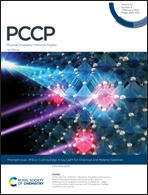On the design of molecular excitonic circuits for quantum computing: the universal quantum gates
Abstract
This manuscript presents a strategy for controlling the transformation of excitonic states through the design of circuits made up of coupled organic dye molecules. Specifically, we show how unitary transformation matrices can be mapped to the Hamiltonians of physical systems of dye molecules with specified geometric and chemical properties. The evolution of these systems over specific time scales encodes the action of the unitary transformation. We identify bounds on the complexity of the transformations that can be represented by these circuits and on the optoelectronic properties of the dye molecules that comprise them. We formalize this strategy and apply it to determine the excitonic circuits of the four universal quantum logic gates: NOT, Hadamard, π/8 and CNOT. We discuss the properties of these circuits and how their performance is expected to be influenced by the presence of environmental noise.



 Please wait while we load your content...
Please wait while we load your content...